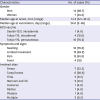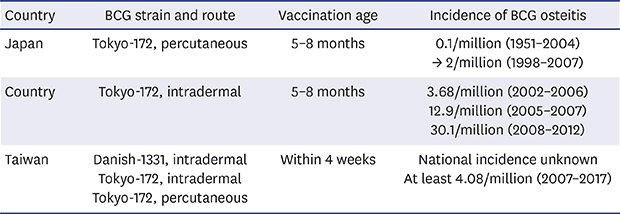1. World Health Organization. BCG vaccines: WHO position paper – February 2018. Wkly Epidemiol Rec. 2018; 93(8):73–96.

2. World Health Organization. BCG vaccine. WHO position paper. Wkly Epidemiol Rec. 2004; 79(4):27–38.

3. Koyama A, Toida I, Nakata S. Osteitis as a complication of BCG vaccination. Kekkaku. 2009; 84(3):125–132.

4. Chiu NC, Lin MC, Lin WL, Wang SY, Chi H, Huang LM, et al.
Mycobacterium bovis BCG-associated osteomyelitis/osteitis, Taiwan. Emerg Infect Dis. 2015; 21(3):539–540.


5. Rermruay R, Rungmaitree S, Chatpornvorarux S, Brukesawan C, Wittawatmongkol O, Lapphra K, et al. Clinical features and outcomes of Bacille Calmette-Guérin (BCG)-induced diseases following neonatal BCG Tokyo–172 strain immunization. Vaccine. 2018; 36(28):4046–4053.


6. Yamamoto S, Yamamoto T. Historical review of BCG vaccine in Japan. Jpn J Infect Dis. 2007; 60(6):331–336.

7. Toida I, Nakata S. Severe adverse reactions after vaccination with Japanese BCG vaccine: a review. Kekkaku. 2007; 82(11):809–824.

8. Shue GC, Yang SL, Lee CD, Liu DP. Adverse events induced by BCG immunization in Taiwan. Taiwan Epidemiol Bull. 2008; 24(5):357–371.
9. Kim SH, Kim SY, Eun BW, Yoo WJ, Park KU, Choi EH, et al. BCG osteomyelitis caused by the BCG Tokyo strain and confirmed by molecular method. Vaccine. 2008; 26(34):4379–4381.


10. Yoo WJ, Choi IH, Yun YH, Cho TJ, Cheon JE, Song MH, et al. Primary epiphyseal osteomyelitis caused by mycobacterium species in otherwise healthy toddlers. J Bone Joint Surg Am. 2014; 96(17):e145.

11. Lin WL, Chiu NC, Lee PH, Huang AS, Huang FY, Chi H, et al. Management of Bacillus Calmette-Guérin osteomyelitis/osteitis in immunocompetent children-a systematic review. Vaccine. 2015; 33(36):4391–4397.


12. Peltola H, Pääkkönen M. Acute osteomyelitis in children. N Engl J Med. 2014; 370(4):352–360.


13. Goergens ED, McEvoy A, Watson M, Barrett IR. Acute osteomyelitis and septic arthritis in children. J Paediatr Child Health. 2005; 41(1-2):59–62.


14. Pöyhönen L, Pauniaho SL, Kröger L, Korppi M. Orthopedic complications in former Bacillus Calmette-Guérin osteitis patients. Pediatr Infect Dis J. 2016; 35(5):579–580.


15. Böttiger M, Romanus V, de Verdier C, Boman G. Osteitis and other complications caused by generalized BCG-itis. Experiences in Sweden. Acta Paediatr Scand. 1982; 71(3):471–478.

16. Lotte A, Wasz-Höckert O, Poisson N, Dumitrescu N, Verron M, Couvet E. BCG complications. Estimates of the risks among vaccinated subjects and statistical analysis of their main characteristics. Adv Tuberc Res. 1984; 21:107–193.

17. Kröger L, Brander E, Korppi M, Wasz-Höckert O, Backman A, Kröger H, et al. Osteitis after newborn vaccination with three different Bacillus Calmette-Guérin vaccines: twenty-nine years of experience. Pediatr Infect Dis J. 1994; 13(2):113–115.

18. Lotte A, Wasz-Höckert O, Poisson N, Dumitrescu N, Verron M, Couvet E. A bibliography of the complications of BCG vaccination. A comprehensive list of the world literature since the introduction of BCG up to July 1982, supplemented by over 100 personal communications. Adv Tuberc Res. 1984; 21:194–245.

26. Ministry of Health and Welfare (KR). Ministry of Health and Welfare Statistical Yearbook 2012. Seoul: Ministry of Health and Welfare;2012.
27. Ministry of Health and Welfare (KR). Ministry of Health and Welfare Statistical Yearbook 2017. Seoul: Ministry of Health and Welfare;2017.
28. Thamthitiwat S, Marin N, Baggett HC, Peruski LF, Kiatkulwiwat W, Panumatrasmee V, et al.
Mycobacterium bovis (Bacille Calmette-Guérin) bacteremia in immunocompetent neonates following vaccination. Vaccine. 2011; 29(9):1727–1730.

29. Lee HJ, Sohn YM, Kim JS, Kim YT, Lee JG, Choi BY. Analysis of the adverse events following immunization of the national compensation program and the surveillance system in Korea, 1995–2000. Korean J Pediatr Infect Dis. 2001; 8(2):135–149.
31. Korea Centers for Disease Control and Prevention. Guidelines for the Adverse Events Following Immunization Management. Cheongju: Korea Centers for Disease Control and Prevention;2014.






 PDF
PDF Citation
Citation Print
Print





 XML Download
XML Download